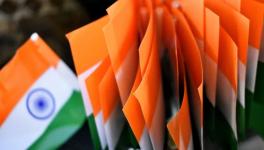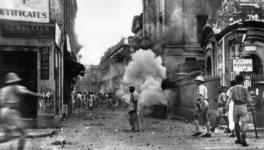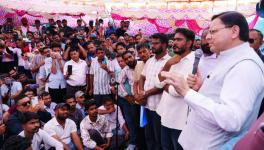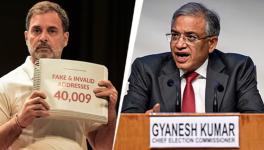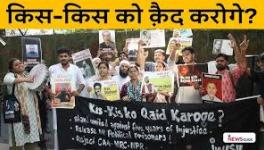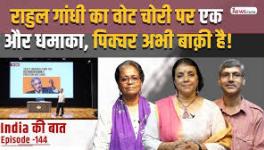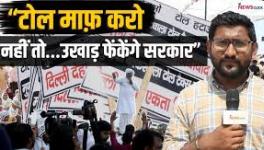The ‘Work’ of Politics in Times of Polarisation
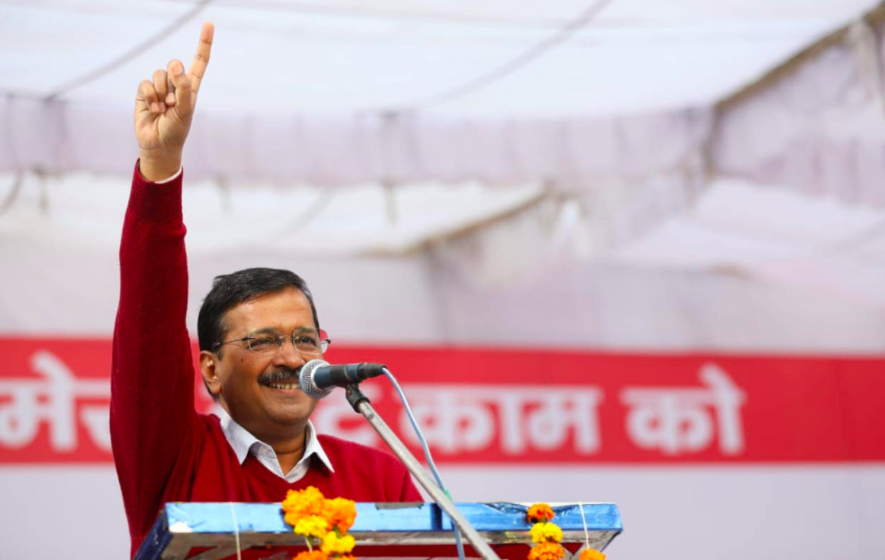
These were not voters in Delhi. Standing or sitting by the road at Hauz Rani main road with their heads bowed, they were labourers from Bihar hoping to be picked up for a day’s work by some contractor. Nor were they communicative. But they made their point when they talked.
Yes, they had heard from their neighbours that Aam Aadmi Party (AAP) had done kaam (work). But in Bihar they would vote for Nitish Kumar. When asked what they would feel if Nitish broke away from ally Bharatiya Janata Party (BJP), one of them smiled confidently and said that ultimately they would get together again.
The labourers summed up a near seamless relationship between voting for different parties, some of which were in formal opposition to one another and others whose relationships were suspect.
A day-long survey of four electoral constituencies spanning Kalkaji, Malviya Nagar, Greater Kailash and Delhi Cantonment, speaking at some length to about 30-40 odd people as individuals and in groups, yielded roughly a similar picture to what the labourers painted. As predicted by many surveys, it was the AAP in the lead for Delhi with a relatively unequivocal support for the BJP at the Centre. The Congress popped up in unexpected corners. But there were also significant angularities that did not fit this picture.
More important, however, was the nature of issues that was being forefronted by would-be voters. The labourers of Hauz Rani initiated what was to become a major theme among AAP supporters, that is, that the jharoo (AAP’s election symbol – the broom) had done kaam. This was an interesting departure from earlier impressions of electoral surveys in Delhi, in which AAP supporters raised issues of corruption and the alienation from the swanky “suit boot Sarkar” of Narendra Modi.
Instead, now there was a dwelling on what AAP had done for the local communities. Many said that they knew AAP had done work from their neighbours. But many more could list the specific things AAP had done. A group of elders sunning themselves in a Malviya Nagar park listed various items: sewage pipes, tubewells, water pipes that could be shared between two households, latrines, free rides for women, the schools that had improved so tremendously that those who had their children in private institutions were now planning to transfer their wards to government schools. A Mr Gupta in the Malviya Nagar market, who runs a big vegetable stall, told us directly, “You don’t know what it is to live in a jhuggi; but AAP has done so many things like building latrines, extending water pipes, setting up schools for both boys and girls and so on, that has changed life for people like us.”
It is quite interesting that while the large hoardings for AAP advertised Kejriwal’s contribution, the overwhelming number of supporters did not mention him. It was always the generic “jharoo” and the invocation of “kaam”. By itself this can be seen to represent a pragmatic, non-ideological politics. To be more accurate, it is a politics of local accountability. To a great extent this is what it is. But it is also a departure from paternalist politics of welfare. An elderly Muslim gentleman at a Malviya Nagar park told us, “We have got these things without asking for it. It will be difficult to reverse these by any opposition party after this.” They have been “given” things that change their everyday life in immediate and direct ways, not by what the State judges to be good for its people. It is obviously different from big development projects that command symbolic value and yield deferred, if not ambiguous, returns for local populations. Furthermore, there is a sense of respect and dignity that the recipients have been afforded in this transaction. It suspends the pattern of bargaining with the State through demonstrations, loss of reputation inflicted by big media house campaigns and sometimes, human lives from police bullets. When kaam is combined with the personal accessibility of the local MLA, then the combination becomes very potent. This was, for instance, the case with Somnath Bhardwaj. Sailendra, a shopkeeper, described how easy it was to get access to Bhardwaj for any specific work. With an accessible representative, work/ kaam starts to describe a relationship of political intimacy.
Kaam also acquires other connotations in an election in which the BJP jettisoned its development agenda mid-way through the campaign – and instead shifted its agenda to communal polarisation, centred on Shaheen Bagh. For Muslims, there is complete focus on kaam that bypasses any interest on Shaheen Bagh. Only one Muslim gentleman, when asked repeatedly about polarisation, broke out to say that the BJP has three things on its mind, “Pakistan, Muslims and Shaheen Bagh”. But he personally wasn’t interested in those issues.
Nadeem, a young Muslim shopkeeper represented himself as a member of the youth and talked about unemployment. He stated that they were being forced to migrate to do “ghulami” in the US and Afghanistan because they got no opportunities in a Hindustan that was suffering from “over-competition”.
Kaam clearly opens up new avenues for alignments across community lines even as it staves off the rhetoric of communal polarisation.
Some of the Sikh gentlemen we met were even more forthcoming. We met Parampreet Singh inside his furnishings shop. Initially reluctant, he fobbed off questions by saying everyone was good in their own place. Pushed further, he finally stated, “…look there is no development where religion is in charge. Look at the Islamic countries.” Another Sikh shopkeeper in Malviya Nagar, Devender Singh Chatwal, silently showed us video clips of the hundreds of crores being spent by BJP in setting up its new headquarters and in installing statues made, as he put it, in China.
Possibly the most interesting case, however, was that of Dilip Kumar Gupta from Faizabad. He expressed great pride in the establishment of the Ram temple there. He had also voted for BJP in the last two general elections. But speaking about communal polarisation, he was equally clear. He said that they lived cheek by jowl with Muslim neighbours and never had any problems with them. It was only the politicians who created all the “hungama”. He then gave to his critique of communalism a paternalist twist. He declared that, “Are Hindus so weak that we cannot defend our daughters and sisters? We don’t need political parties to do that for us. Why do they go on about this?”
There is a creeping ennui about communal enmity that was evident amongst the minorities -- and even in sections of Hindus. It may be too much to say that is because of the politics of kaam. But certainly, the centre stage that kaam has taken amongst the issues in this election, facilitates the re-emergence of a broad discourse of secularism. This is the more remarkable since it does not echo a party line, top down languages of secularism, but is, as it were, emerging from below with its own twists and complexities.
But it is equally clear that kaam has, by no means, removed the sense of Hindu consolidation. Many respondents were very clear about this and spoke out against Shaheen Bagh. But there were no real positive reasons to vote for BJP that they could provide, except one of whom talked about how terror strikes had become a thing of the past. What a tilak-dhari man distributing prasad declared was that the BJP campaign was slow-moving till Modi stepped into the scene. Indeed, the BJP campaign is massively dependent on Modi. Many said that they voted not for the BJP which was like any other party, but for Modi.
Asked what it was about Modi that attracted them, they looked non-plussed initially. They then came up with different answers. Some said he filled them with “josh” (enthusiasm) through his speeches; others talked about his decisiveness. But clearly here was a man who had now transcended his earlier stature as the head of a “sarkar” (government) to one who was beyond it.
On the other side, the clear implication of this reverence was the relative ineffectiveness of home minister Amit Shah as a campaigner. There was one reference to him and that too was negative. His meeting at Malviya Nagar occasioned a criticism that the security had shut down the entire market at a time when business had slowed down.
Of course, kaam is no magic wand. When there is no work to show, as has happened at Delhi Cantonment, many are quite ready to jettison the ruling AAP candidate. Here there was a surge of interest for the Congress candidate who was local. At the same time, two young shop-girls, when asked about their choices, broke out into a spontaneously glowing declaration that they would vote for none other than Modi. Later, however, one of them whispered to us that for these elections she would vote for AAP.
On the other side, a stable constituency of the earlier elections, that is, the auto-rickshwallahs, no longer appeared persuaded by the AAP magic. For them life had become far too difficult: challans had gone up and they were facing fierce competition from e-rickshaws and App-based platforms. It was a struggle to earn more than the Rs 450 that was the basic cost of running the auto every day. Often they had little to show to their homes at the end of the day. Their discourse was framed by a class antagonism -- inflected by sexism. Lokesh, a young autorickshaw driver, observed bitterly how rich and poor rapists were differentially treated. Not quite being an ideology, kaam is far more contingent and dependent on the actual results for everyday life that is yielded by governance. This may well be where the BJP still scores over AAP. They have an ideology, assiduously repeated by grassroots workers, which ensures a durability of support that can survive the actual non-performance of their government.
Nevertheless it is also true that BJP voters appear to lack the conviction they possessed in the Lok Sabha elections. Paradoxically, communal antagonism needs more than just itself to become a decisive vote in its favour. It needs either a sense of immediate fear (national security, major riots), pride (for instance, Ram Janmabhoomi) and/or development. While it has none of these in its armoury in these elections, the BJP still have a fourth element, that is, a charismatic leader in Modi, who is greater than his blunders. But clearly this is not enough to provide the extra boost. It was always the AAP supporters who spoke with eloquence and feeling.At least for these elections, the politics of kaam has changed the balance of political passions.
The writer teaches political thought at Jawaharlal Nehru University, Delhi. The views are personal.
Get the latest reports & analysis with people's perspective on Protests, movements & deep analytical videos, discussions of the current affairs in your Telegram app. Subscribe to NewsClick's Telegram channel & get Real-Time updates on stories, as they get published on our website.









